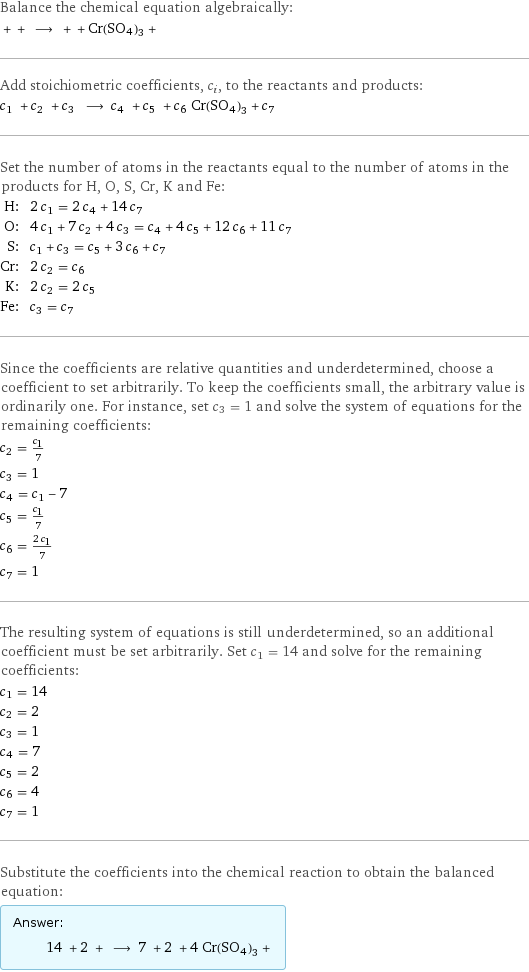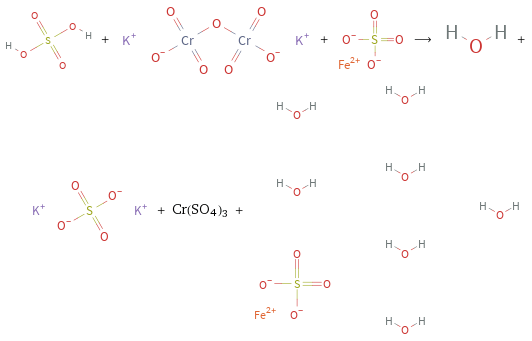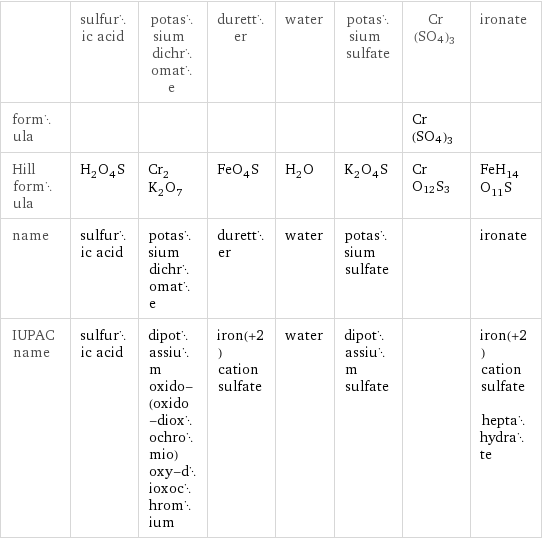Input interpretation

sulfuric acid + potassium dichromate + duretter ⟶ water + potassium sulfate + Cr(SO4)3 + ironate
Balanced equation

Balance the chemical equation algebraically: + + ⟶ + + Cr(SO4)3 + Add stoichiometric coefficients, c_i, to the reactants and products: c_1 + c_2 + c_3 ⟶ c_4 + c_5 + c_6 Cr(SO4)3 + c_7 Set the number of atoms in the reactants equal to the number of atoms in the products for H, O, S, Cr, K and Fe: H: | 2 c_1 = 2 c_4 + 14 c_7 O: | 4 c_1 + 7 c_2 + 4 c_3 = c_4 + 4 c_5 + 12 c_6 + 11 c_7 S: | c_1 + c_3 = c_5 + 3 c_6 + c_7 Cr: | 2 c_2 = c_6 K: | 2 c_2 = 2 c_5 Fe: | c_3 = c_7 Since the coefficients are relative quantities and underdetermined, choose a coefficient to set arbitrarily. To keep the coefficients small, the arbitrary value is ordinarily one. For instance, set c_3 = 1 and solve the system of equations for the remaining coefficients: c_2 = c_1/7 c_3 = 1 c_4 = c_1 - 7 c_5 = c_1/7 c_6 = (2 c_1)/7 c_7 = 1 The resulting system of equations is still underdetermined, so an additional coefficient must be set arbitrarily. Set c_1 = 14 and solve for the remaining coefficients: c_1 = 14 c_2 = 2 c_3 = 1 c_4 = 7 c_5 = 2 c_6 = 4 c_7 = 1 Substitute the coefficients into the chemical reaction to obtain the balanced equation: Answer: | | 14 + 2 + ⟶ 7 + 2 + 4 Cr(SO4)3 +
Structures

+ + ⟶ + + Cr(SO4)3 +
Names

sulfuric acid + potassium dichromate + duretter ⟶ water + potassium sulfate + Cr(SO4)3 + ironate
Chemical names and formulas

| sulfuric acid | potassium dichromate | duretter | water | potassium sulfate | Cr(SO4)3 | ironate formula | | | | | | Cr(SO4)3 | Hill formula | H_2O_4S | Cr_2K_2O_7 | FeO_4S | H_2O | K_2O_4S | CrO12S3 | FeH_14O_11S name | sulfuric acid | potassium dichromate | duretter | water | potassium sulfate | | ironate IUPAC name | sulfuric acid | dipotassium oxido-(oxido-dioxochromio)oxy-dioxochromium | iron(+2) cation sulfate | water | dipotassium sulfate | | iron(+2) cation sulfate heptahydrate